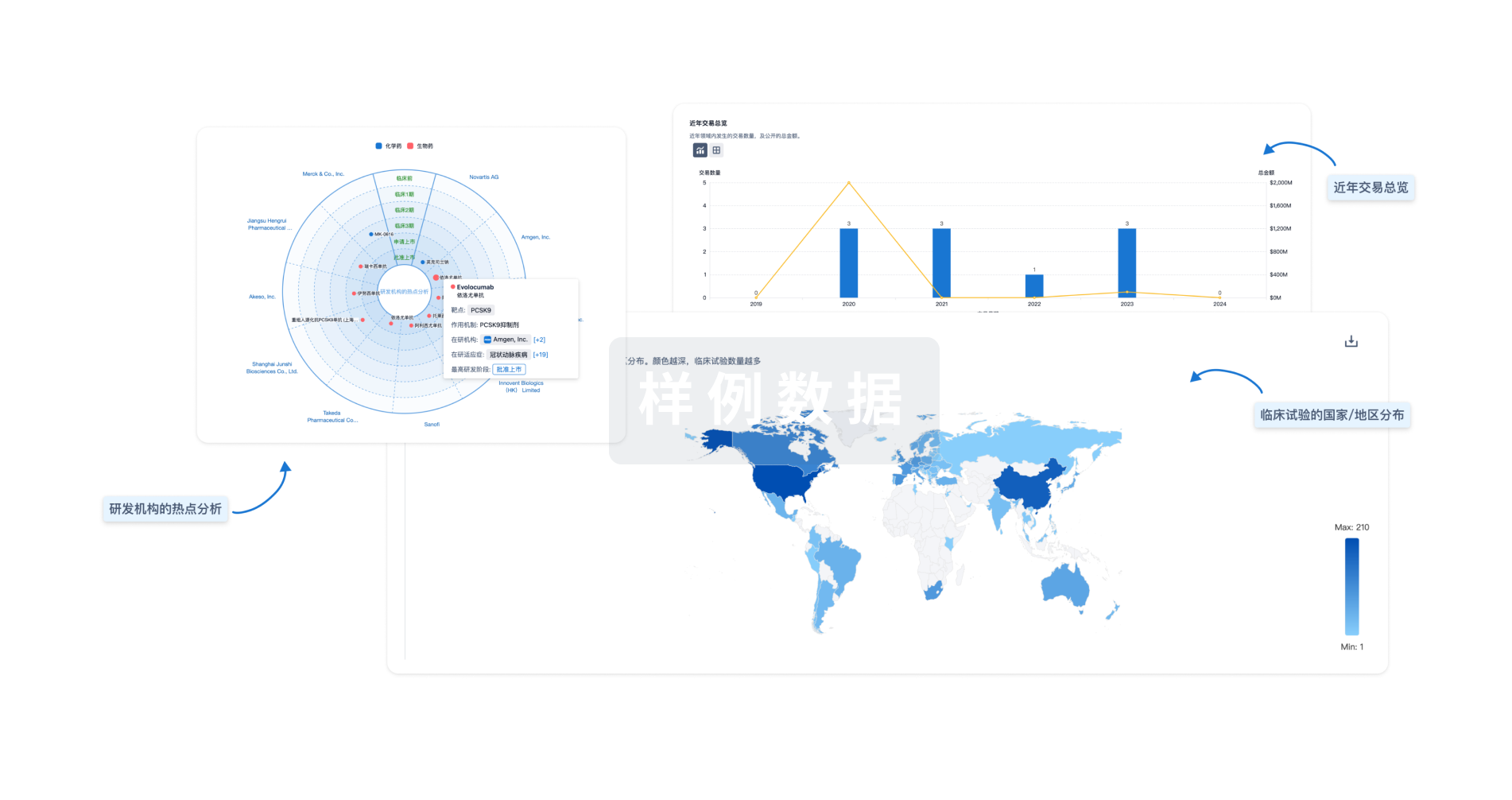预约演示
更新于:2025-05-07
GPR158
更新于:2025-05-07
基本信息
别名 G protein-coupled receptor 158、GPR158、KIAA1136 + [1] |
简介 Metabotropic receptor for glycine that controls synapse formation and function in the brain (PubMed:36996198). Acts as an atypical G-protein coupled receptor that recruits and regulates the RGS7-GNB5 complex instead of activating G proteins (PubMed:31189666, PubMed:36996198). In absence of glycine ligand, promotes the GTPase activator activity of RGS7, increasing the GTPase activity of G protein alpha subunits, thereby driving them into their inactive GDP-bound form (PubMed:36996198). Glycine-binding changes the conformation of the intracellular surface, inhibiting the GTPase activator activity of the RGS7-GNB5 complex, promoting G protein alpha subunits into their active GTP-bound form and regulating cAMP levels (PubMed:36996198). Also able to bind taurine, a compound closely related to glycine, but with a two-fold lower affinity (PubMed:36996198). Glycine receptor-dependent regulation of cAMP controls key ion channels, kinases and neurotrophic factors involved in neuronal excitability and synaptic transmission (PubMed:36996198). Plays a pivotal role in regulating mood and cognition via its ability to regulate neuronal excitability in L2/L3 pyramidal neurons of the prefrontal cortex (By similarity). Also involved in spatial learning by regulating hippocampal CA1 neuronal excitability (By similarity). Acts as a synaptic organizer in the hippocampus, required for proper mossy fiber-CA3 neurocircuitry establishment, structure and function: induces presynaptic differentiation in contacting axons via its interaction with GPC4 (By similarity). In addition to glycine, may also act as a receptor for osteocalcin (BGLAP) hormone: osteocalcin-binding initiates a signaling response that prevents neuronal apoptosis in the hippocampus and regulates the synthesis of neurotransmitters (By similarity). |
关联
1
项与 GPR158 相关的药物WO2024221184
专利挖掘靶点 |
作用机制- |
在研机构 |
原研机构 |
在研适应症 |
非在研适应症- |
最高研发阶段药物发现 |
首次获批国家/地区- |
首次获批日期1800-01-20 |
100 项与 GPR158 相关的临床结果
登录后查看更多信息
100 项与 GPR158 相关的转化医学
登录后查看更多信息
0 项与 GPR158 相关的专利(医药)
登录后查看更多信息
67
项与 GPR158 相关的文献(医药)2025-03-05·Journal of Agricultural and Food Chemistry
Trilobatin, a Naturally Occurring GPR158 Ligand, Alleviates Depressive-like Behavior by Promoting Mitophagy
Article
作者: Luo, Yunmei ; Xie, Dianyou ; Lin, Mu ; Zhu, Yi Zhun ; Wei, Yu ; Gong, Qihai ; Dong, Lan ; Gao, Jianmei
2025-03-01·Progress in Neurobiology
The correct connectivity of the DG-CA3 circuits involved in declarative memory processes depends on Vangl2-dependent planar cell polarity signaling
Article
作者: Gleizes, Marie ; Marighetto, Aline ; Depret, Noémie ; Venugopal, Vasika ; Carvalho, Steve Dos Santos ; Moreau, Maïté Marie ; Ezan, Jérôme ; Mulle, Christophe ; Desmedt, Aline ; Quiedeville, Anne ; Sans, Nathalie ; Racca, Claudia ; Poirault-Chassac, Sonia ; Abed, Alice Shaam Al ; Barthet, Gael ; Montcouquiol, Mireille
2024-12-01·Cellular and Molecular Life Sciences
Glycine-induced activation of GPR158 increases the intrinsic excitability of medium spiny neurons in the nucleus accumbens
Article
作者: Nutarelli, Sofia ; Aceto, Giuseppe ; Pecci, Valeria ; Nardella, Luca ; Colussi, Claudia ; Viscomi, Maria Teresa ; D'Ascenzo, Marcello ; Nanni, Simona ; Bertozzi, Alessia ; Grassi, Claudio
7
项与 GPR158 相关的新闻(医药)2023-07-06
·生物谷
7月5日晚,歌手李玟因抑郁症去世的消息刷屏全网,这不由得让我们想到抑郁症真的有这么可怕吗?抑郁症如何控制和治疗呢?如今科学界在抑郁症研究领域又取得了哪些成果,本文中,小编就对今年科学家们在抑郁症研究领域取得的重要成果进行整理,分享给大家!【1】Mol Psych:抑郁症或与某些人群机体的免疫反应有关doi:10.1038/s41380-022-01919-7近日,一篇发表在国际杂志Molecular Psychiatry上题为“Peripheral blood cellular immunophenotype in depression:a systematic review and meta-analysis”的研究报告中,来自布里斯托大学等机构的科学家们通过研究揭示了机体抑郁症的发生或许与血液中多种类型免疫细胞的数量变化之间存在一定的关联,相关研究结果表明,机体免疫系统(先天性和适应性免疫反应)不同组成部分的改变或许在诱发抑郁症上扮演着关键角色。抑郁症或与某些人群机体的免疫反应有关。图片来源:Molecular Psychiatry (2022). DOI:10.1038/s41380-022-01919-7尽管此前在这一研究领域进行过很多孤立的研究,但本文研究中,研究人员首次进行了大规模的调查来分析并统计性地结合所有研究的数据,这些数据是通过流式细胞仪对诊断为抑郁症患者和非抑郁症患者测定的免疫细胞的数量,通过结合这些研究并增加参与研究的总人数或许就能得出更明确的结论。文章中,研究人员系统性地搜索了两个数据库,并汇集了来自27篇已经发表的文章中的数据,这些文章比较了抑郁症患者和未患抑郁症个体机体19种免疫细胞的计数或数量,每项研究都经过了质量检查,仅有高质量的研究才会被纳入本研究中。研究人员对2277名个体进行分析后发现,相比未患抑郁症的健康对照组个体而言,抑郁症患者机体中8种不同类型的免疫细胞(比如B细胞和T细胞)的数量都会发生增加。【2】Nat Aging:血液中的特殊蛋白或与人类抑郁症的发生直接相关doi:10.1038/s43587-022-00352-3衰老的过程往往与机体神经系统症状的发生直接相关,比如认知功能下降、记忆丧失和诸如抑郁症等情绪障碍等,此前研究结果表明,血液中存在的名为GDF11的生长因子或许对于衰老小鼠的嗅觉感知和其大脑中新细胞的产生具有一定的益处,然而,目前研究人员并不清楚GDF11在大脑中的作用机制。近日,一篇发表在国际杂志Nature Aging上题为“Systemic GDF11 attenuates depression-like phenotype in aged mice via stimulation of neuronal autophagy”的研究报告中,来自巴黎西岱大学等机构的科学家们通过研究发现,长期给予老年小鼠GDF11蛋白或能改善其机体的记忆并能明显减少其与抑郁症相关的行为障碍,从而就能使得小鼠恢复到与年轻小鼠机体类似的行为。文章中,研究人员对不同的老年小鼠模型或出现抑郁症样行为障碍的小鼠模型进行研究,同时还对体外的神经培养物进行了研究分析,从而就能帮助他们识别出GDF11作用的分子机制,结果发现,给予GDF11或能激活大脑中被称之为“自噬”(autophagy)的细胞内清洁的自然过程,并能消除衰老的细胞;GDF11蛋白还能间接增加大脑海马体中的细胞周转率并恢复大脑中的神经元活性。为了更好地理解人类的抑郁症行为和GDF11蛋白之间的关联,研究人员对患有严重抑郁症的国际队列中的年轻患者机体血清中的特殊蛋白进行了量化分析,他们观察到,GDF11的水平在这些患者机体中会变得明显较低;此外,通过测定这种蛋白在不同阶段的水平变化,他们还观察到了该蛋白的水平波动或许取决于个体机体的抑郁症状态。【3】Cell:基于迷幻药伊博格碱,开发出两种可能用于治疗成瘾和抑郁症的新候选药物doi:10.1016/j.cell.2023.04.010近日,一篇发表在国际杂志Cell上题为“Structure-based discovery of conformationally selective inhibitors of the serotonin transporter”的研究报告中,来自美国加州大学旧金山分校等机构的研究人员根据非洲传统迷幻植物药物伊博格碱(ibogaine)的药理学原理,开发出两种可能用于治疗成瘾和抑郁症的新候选药物。在非常低的剂量下,这两种新的化合物能够减轻小鼠这两种疾病的症状。图片来源:Cell, 2023, doi:10.1016/j.cell.2023.04.010。这些研究结果从伊博格碱对5-羟色胺转运体(serotonin transporter, SERT)的影响中得到启发,SERT也是氟西汀(fluoxetine, 商品名为Prozac)等SSRI抗抑郁药的作用靶标。这些作者虚拟地筛选了2亿种分子结构,以找到与伊博格碱相同方式阻断SERT的分子。研究者Brian Shoichet博士说,“有些人相信伊博格碱可以治疗成瘾,但它并不是一种很好的药物。它有不好的副作用,而且在美国还没有被批准使用。我们的化合物只是模拟了伊博格碱众多药理作用中的一种,而且仍然重现了它对行为最理想的影响,至少在小鼠身上是这样。”其他的论文共同通讯作者为加州大学旧金山分校的Allan Basbaum博士和Aashish Manglik博士;耶鲁大学的Gary Rudnick博士;杜克大学的Bill Wetsel博士。这些作者证实了这两种新的化合物的现实前景,它们最初是用Shoichet开发的计算对接方法鉴定出来的。这种计算对接方法涉及系统地测试与蛋白结合的虚拟化学结构,使科学家们能够确定新的药物线索,而不必在实验室中合成它们。研究者表示,这类项目首先要可视化观察与一种蛋白相匹配的分子类型,接着对接分子文库,优化,然后依靠一个团队来展示这些分子的作用。如今我们知道靶向SERT有很多未开发的治疗潜力。”【4】Transl Psych:新发现!一种跳跃基因或与机体抑郁症、恐惧和焦虑症发生直接相关!doi:10.1038/s41398-022-02078-71996年,来自日本的科学家Tadashi Yamamoto在实验室首次发现,Tob基因在癌症发生过程中扮演着关键角色,此前的相关研究也表明,Tob基因在调节细胞周期和机体的免疫反应上也发挥着重要作用。近日,一篇发表在国际杂志Translational Psychiatry上题为“TOB is an effector of the hippocampus-mediated acute stress response”的研究报告中,来自日本冲绳科学技术研究所等机构的科学家们通过研究发现,Tob基因或许在调节机体抑郁症、恐惧和焦虑症方面扮演着重要作用。这项研究中,研究人员主要对机体的抗压能力进行了研究,研究者发现,Tob基因的存在或能帮助抗压,如果其被移除的话,机体的抑郁、恐惧和焦虑水平就会增加。Tob基因以日语动词“tobu”命名,意思是飞行或跳跃,这是因为,当细胞暴露于刺激中时,其蛋白质的水平就会在活动中飞跃,这就导致了该基因被归类为即时早期基因(immediate-early gene),因为其拥有如此快的反应。Tob基因与很多不同的现象都有关,但其对大脑系统的研究尤其具有挑战性,尽管此前其曾被怀疑过,但这项研究中,研究人员首次阐明了Tob基因在大脑中具有对抗压力的功能。该基因与焦虑症、恐惧和抑郁症相关的几轮来自于多项不同的实验,首先,研究人员将小鼠暴露于压力下,正如预期的那样,他们观察到,Tob蛋白的水平增加了,随后他们利用出生时没有Tob基因的小鼠进行研究后,发现小鼠机体中的抑郁、焦虑和恐惧水平增加了,比如,当携带Tob基因的小鼠被放在一个水桶里时,其就会游泳并试图逃跑,然而,没有携带Tob基因的小鼠则只是漂浮着,这种缺乏与困难状况斗争的意愿是研究人员确定动物处于抑郁状态的一种方法。更重要的是,没有Tob基因的小鼠似乎并不会学习;研究者表示,当小鼠被日复一日地放在一个能唤起其恐惧感的地方时,其通常会发现事情似乎并没有那么糟糕,这样其就不再害怕了;但是没有Tob基因的小鼠仍然会表现出恐惧水平的增加。研究人员利用核磁共振成像技术对小鼠进行研究后发现,当小鼠机体中的Tob基因被移除后,调节大脑抗压能力的两个关键地方(海马体和前额叶皮层)之间的连接发生了改变。于是,研究人员决定分析该基因在海马体中的具体作用或角色,他们利用没有Tob基因的小鼠,并将这种基因注射到小鼠的海马体中,同时让该基因在小鼠机体其它部位不存在,结果发现,小鼠机体的恐惧感和抑郁程度恢复到了正常水平,但其焦虑症仍然会增加。【5】CRFSN:新发现!维生素D补充剂似乎能减轻抑郁症患者的疾病症状!doi:10.1080/10408398.2022.2096560近日,一篇发表在国际杂志Critical Reviews in Food Science and Nutrition上题为“The effect of vitamin D supplementation on depressive symptoms in adults:A systematic review and meta‐analysis of randomized controlled trials”的研究报告中,来自东芬兰大学等机构的科学家们通过进行一项广泛的荟萃分析,结果发现,维生素D补充剂或能减轻抑郁症成年人机体的抑郁症状,这项荟萃分析包括来自全球各地的几十项研究。抑郁症症状在全球范围内给患者带来了巨大的疾病负担,目前的抗抑郁药物的疗效往往是不够的,这就是为何科学家们一直在寻找能减缓抑郁症症状的方法的原因,比如从营养学研究中来寻找合适的方法。维生素D被认为能调节机体中枢神经系统的功能,这些功能的紊乱往往被认为与抑郁症发生直接相关,此外,横断面研究也观察到了抑郁症症状和机体维生素D缺乏之间的关联,然而,此前揭示维生素D补充剂对抑郁症影响效应的荟萃分析所得到的结果往往并不确定,在荟萃分析中,多个不同的研究结果往往会被结合起来并进行统计学分析。本文研究中,研究人员所进行的关于维生素D补充剂和抑郁症之间关联的最新荟萃分析是迄今为止发表的文章中最大的一项研究,其包括来自全球41项研究的结果,这些研究通过在不同人群中进行随机安慰剂对照试验,调查了维生素D在减缓患者抑郁症症状上的影响效应,这些研究包括在抑郁症患者中、一般人群和存在多种机体状况的参与者中进行,研究结果表明,在减缓抑郁症成年人机体疾病症状上,维生素D补充剂或许要比安慰剂更加有效。研究人员所使用的维生素D的剂量或许存在很大差异,但在通常情况下,维生素D补充剂每天的摄入量为50-100微克。【6】Science:重大进展!揭示孤儿受体GPR158是一种代谢型甘氨酸受体,有望开发出更好的抑郁症治疗方法doi:10.1126/science.add7150近日,一篇发表在国际杂志Science上题为“Orphan receptor GPR158 serves as a metabotropic glycine receptor:mGlyR”的研究报告中,来自美国佛罗里达大学斯克里普斯生物医学研究所的研究人员一种常见的氨基酸---甘氨酸---能够向大脑传递一种“减速”信号,可能导致一些人的重度抑郁症、焦虑症和其他情绪障碍。这一发现提高了人们对重度抑郁症的生物学原因的认识,并可能加速开发新的、起效更快的药物来治疗这种难以治疗的情绪障碍。研究者Kirill Martemyanov博士说,“大多数治疗抑郁症患者的药物需要数周时间才能起作用,如果它们真的起作用的话。我们真地需要新的和更好的选择。”重度抑郁症是世界上最紧迫的健康需求之一。近年来,它的数量激增,特别是在年轻的成年人中。随着抑郁症致残、自杀人数和医疗费用的攀升,美国疾病控制与预防中心2021年的一项研究(PharmacoEconomics, 2021, doi:10.1007/s40273-021-01019-4)认为,美国每年的经济负担为3260亿美元。Martemyanov说,他和他的研究团队为这一发现花费了多年时间。他们并没有着手寻找一个原因,更没有寻找一种可能的抑郁症治疗途径。相反,他们提出了一个基本问题:脑细胞上的传感器如何接收和传输信号到细胞内?Martemyanov猜测,这就是理解视觉、疼痛、记忆、行为以及可能更多东西的关键所在。Martemyanov说,“基础科学的发展真是令人惊讶。15年前,我们发现了我们感兴趣的蛋白的一种结合伴侣,这使我们找到了一种新的受体。我们在这段时间里一直在解决这个问题。”2018年,Martemyanov团队发现这种新受体参与了压力诱发的抑郁症(eLife, 2018, doi:10.7554/eLife.33273)。如果小鼠缺乏这种称为GPR158的受体的基因,它们对慢性压力的抵抗力惊人地强。他说,这提供了强有力的证据表明GPR158可能成为一种治疗靶标。但是是什么发出信号呢?【7】Psychoneuroendocrinology:较高的皮质醇水平或能帮助预测个体未来患抑郁症的风险doi:10.1016/j.psyneuen.2022.105847确定暴露于新型压力源后抑郁症和其它心理健康后遗症的预先存在的生物性风险标志物或许能帮助识别出易感个体和机制途径;近日,一篇发表在国际杂志Psychoneuroendocrinology上题为“Hair cortisol as a risk marker for increased depressive symptoms among older adults during the COVID-19 pandemic”的研究报告中,来自都柏林圣三一学院等机构的科学家们通过研究发现,高水平的压力激素皮质醇或会增加机体患抑郁症的风险。图片来源:https://www.sciencedirect.com/science/article/pii/S0306453022001883?via%3Dihub研究者表示,通过对2014年收集的老年人群的毛发样本进行检测发现,高水平的皮质醇或与参与者6年后COVID-19大流行的最初几个月里其患抑郁症的可能性增加有关;头发中的皮质醇被认为能反映机体此前的压力暴露情况以及其它生物学和心里因素,但目前研究人员尚未阐明其中的机制。在目前患抑郁症的个体中,研究人员有时能观察到其机体中含有高水平的皮质醇,然而研究结果表明,以这种方式所测定的皮质醇或许能帮助预测在一段时间的压力加剧后哪些个体更易于患上抑郁症。在COVID-19大流行的第一年对60岁及以上的人群进行研究后发现,男性和女性之间的结果似乎并没有差异。研究者Joanne Feeney说道,由于爱尔兰老龄化纵向研究计划(TILDA,The Irish Longitudinal Study on Aging)多年来一直在收集数据,因此我们能够及时回顾2014年测定参与者样本中皮质醇水平的时间,并调查是否这与在COVID-19期间人群患抑郁症风险的增加是否相关。【8】吸烟或会增加人群患抑郁症和精神分裂症的风险原始出处:New report finds smoking increases the risk of depression and schizophrenia近日,来自布里斯托大学的科学家们通过研究发现,吸烟或会使得人群患精神分裂症的风险增加53%-127%,患抑郁症的风险增加54%-132%,研究人员表示,后期他们还需要进行更为深入的研究来确定为何会发生这种情况,对于诸如焦虑或躁郁症等心理疾病而言,或许也需要更多的研究证据。在近日举办的皇家精神病学院国际大会上,研究人员将相关证据与政府部门进行了分享,目前政府部门正在制定一项新的烟草管控计划,计划于几年晚些时候公布。这项大会还将获得有关精神健康状况的吸烟人群数的新数据,存在精神健康状况的人群或许要比没有精神健康状况的人群吸烟率要高得多,而在英格兰目前有600万吸烟人群,其中包括:1)23万人患有严重的精神疾病,比如精神分裂症和双向情感障碍等;2)160万人患有抑郁症和焦虑症。这些分析非常及时,因为目前政府部门正在考虑研究人员提出的即将出台的烟草控制计划的建议,从而实现2030年的无烟目标,政府部门将会进行独立审查以帮助政府确定最具影响力的干预措施,从而减少人群的吸烟量,并支持人们用于停止吸烟,研究者提出的15项建议之一就是需要采取行动来解决人群的吸烟和心理健康的问题。【9】Biol Psych:新发现!抑郁症和阿尔兹海默病或许有着共同的遗传根源!doi:10.1016/j.biopsych.2021.11.025长期以来,流行病学数据一直将抑郁症与阿尔兹海默病联系在一起,阿尔兹海默病是一种以进行性痴呆症为特征的神经变性疾病,其影响着近600万美国人的健康。近日,一篇发表在国际杂志Biological Psychiatry上题为“Genetic Evidence Supporting a Causal Role of Depression in Alzheimer’s Disease”的研究报告中,来自埃默里大学医学院等机构的科学家们通过研究识别出了抑郁症和阿尔兹海默病的共同遗传因素。重要的是,研究者还发现,抑郁症在阿尔兹海默病的发病过程中扮演着因果关系,而且那些抑郁症患者的记忆力会下降地非常快。医学博士Aliza Wingo说道,本文研究提出了一种可能性,即存在一些基因会导致上述两种基因,尽管其共同的遗传基础很小,但这些研究发现表明,抑郁症对痴呆症或许有着潜在的因果关联。文章中,研究人员进行了全基因组关联性研究(GWAS),其是一种能扫描机体整个基因组从而寻找与特定疾病相关的共同点的技术;GWAS识别出了28个大脑蛋白和75进而转录本(即编码蛋白的信息)与抑郁症发生相关,其中有46个转录本和7个蛋白与阿尔兹海默病的症状相关,这些研究数据表明,这两种疾病或许有着共同的遗传基础,这或许就会增加与抑郁症相关的阿尔兹海默病的发病风险。尽管此前研究中,研究人员利用GWAS技术分析了阿尔兹海默病和抑郁症,但当前的研究工作由于使用了更大且新获得的数据集而变得更加强大,这些数据集揭示了更多的详细信息。本文研究揭示了抑郁症和阿尔兹海默病及相关痴呆症在遗传水平上的关系,这一点非常重要,因为其至少能够部分解释,抑郁症和高风险的痴呆症之间存在已经被证实的流行病学关系。研究者Wingo补充道,这种关系或许就提出了一个问题,即治疗抑郁症是否会减缓机体患痴呆症的风险,我们识别出了能解释抑郁症和痴呆症之间关联的基因,这或许还需要进一步深入研究,诸如此类基因或许有望作为重要的疗法靶点来帮助开发治疗抑郁症并降低机体患痴呆症风险的新型疗法。【10】Science:解析出人脑细胞受体GPR158的三维结构图,有助于开发治疗抑郁症和焦虑症的方法doi:10.1126/science.abl4732近日,一篇发表在国际杂志Science上题为“Cryo-EM structure of human GPR158 receptor coupled to the RGS7-Gβ5 signaling complex”的研究报告中,来自美国斯克里普斯研究所的研究人员利用超冷单粒子电子显微镜(低温电镜)以大约十亿分之一米的分辨率解析出一种名为GPR158的不寻常的脑细胞受体及其与一组介导其活性的蛋白结合在一起时的原子结构图,其中该受体与抑郁症和焦虑症有关。它使得开发通过阻断GPR158来治疗抑郁症、焦虑症和可能的其他情绪障碍的潜在疗法成为可能。GPR158在空载状态和RGS7-Gβ5结合状态下的低温电镜结构图片来源:Science, 2021, doi:10.1126/science.abl4732。研究者Kirill Martemyanov博士说,“我们已经研究这种受体超过10年了,并对它做了大量的生物学研究,所以第一次看到它的结构,真的很令人高兴。”临床忧郁症(clinical depression),也被称为重度抑郁症(major depressive disorder),估计在给定的任何一年都会影响到美国大约2000万人。目前的治疗方法(包括单胺)对其他已知的受体起作用,但并不总是对所有的人都有效,需要有替代的选择方案。Martemyanov和他的团队在2018年的一项研究中已发现,在被诊断为重度抑郁症的人死亡时,GPR158在他们的前额皮层中存在异常高的水平。他们还发现,将小鼠暴露在慢性应激下会增加小鼠前额叶皮层中的这种受体水平,导致类似抑郁症的行为,然而阻断遭受慢性应激的小鼠中的GPR158活性会使它们对抑郁症和应激的影响产生抵抗力。此外,GPR158受体的活性也与前列腺癌有关。从历史上看,GPR158并不容易研究。它被称为“孤儿受体(orphan recepto)”,因为科学家们还没有确定负责以类似于打开开关的方式“开启”其信号传递功能的分子。这种受体也被认为是不寻常的,因为在大脑中,与它所在蛋白家族中的大多数受体不同,它与一种叫做RGS信号复合物的蛋白复合物紧密结合在一起。RGS是“G 蛋白信号转导调节因子”的简称,它对细胞信号传导起着强有力的制动作用。然而,一直不清楚为什么GPR158会与它结合。生物谷更多精彩盘点!敬请期待!会议推荐1大会信息 会议名称 | 2023第六届单细胞多组学研究与临床应用峰会会议时间 | 2023年9月14-15日会议地点 | 上海虹桥西郊丽笙大酒店大会规模 | 800人主办单位 | 生物谷扫码立即报名
临床研究
2023-05-13
·生物探索
一项最新研究发现,一种常见的氨基酸——甘氨酸,可以向大脑发送"刹车"信号,可能影响某些人身上的重度抑郁、焦虑和其他情绪障碍。此项研究的成果以“Orphan receptor GPR158 serves as a metabotropic glycine receptor:
mGlyR”为题于3月30日在线发表于Science。图1 研究成果(图源:[1])该研究对于深入了解重度抑郁症的生物学原因有所助益,并且能够加速开发新型、作用更快的药物治疗难以治愈的情绪障碍。来自佛罗里达州斯克里普斯研究中心生物医学创新与技术研究所的神经科学家Kirill Martemyanov博士是该研究的通讯作者。Martemyanov表示,目前针对抑郁症的药物种类有限,即使能够起效,大多也需经过数周的时间。因此,迫切需要新型和更好的药物选择。随着近年来抑郁症的残疾人数、自杀人数和医疗开支的攀升,美国疾病预防和控制中心于2021年的一项研究指出,由此造成的经济负担约为每年3260亿美元。Martemyanov表示,自己和团队的博士后、学生花费了多年时间来寻找这一发现。他们并没有打算寻找什么病因,更没有去探索可能的治疗方案。相反,他们提出了一个最基本问题:大脑细胞上的传感器如何接收和传输信号到细胞内部,然后改变细胞的活动?Martemyanov认为,这可能是理解视觉、疼痛、记忆、行为和其他潜在功能的关键。2018年,Martemyanov团队发现这种新受体GPR158参与了压力性抑郁症。如果小鼠缺乏这个受体的基因,他们对慢性压力表现出惊人的适应性。这提供了强有力的证据,证明GPR158可能是治疗靶点。但是是什么发送信号呢?“基础科学的发展日新月异。十五年前,我们发现了我们感兴趣的蛋白质的一个结合伙伴,这启发我们发现了这个新的受体,”Martemyanov说。“我们一直在尝试揭开这个谜团。”2021年,他的团队突破性地解析了GPR158的结构。结果让他们感到惊讶。GPR158受体看起来像一个微型的夹子,带有一个隔间,更类似于细菌而不是人类细胞中的结构。“在看到结构之前,我们完全弄错了目标。”Martemyanov说。“但这个结构显然是一个氨基酸受体。氨基酸只有20种,所以我们立刻筛选,并发现只有一种完美贴合,它就是甘氨酸。”值得注意的是,传导到细胞内的信号分子不是激动剂,而是抑制剂。GPR158的功能端与一个合作分子相连,当与甘氨酸结合时,该分子会“踩下刹车”而不是“油门”。研究的第一作者、Martemyanov小组的博士后研究员Laboute表示:“通常,像GPR158这样的受体,被称为G蛋白偶联受体,会与细胞膜内侧的G蛋白相连。但GPR158与RGS(Regulators of G protein signaling) 蛋白相连。”RGS蛋白的主要作用是负向调节G蛋白偶联受体的信号转导途径。因此,负负得正,甘氨酸的存在将减缓GPR158下游Gαo蛋白的失活。大脑的内侧前额叶皮层是一个和抑郁密切相关的区域,在这里,GPR158显著表达。同时,该区域也发现了甘氨酸及其转运蛋白。这些都暗示GPR158可以作为抗抑郁药开发的新靶点。图2甘氨酸对 mGlyR 影响机制的示意图(图源:[1])这项发现意味着GPR158不再是孤儿受体了,团队重新命名它为mGlyR,短称“代谢型甘氨酸受体”。图3 甘氨酸与GPR158相互作用示意图(图源:Wertheim
UF Scripps Institute Martemyanov 实验室)“研究孤儿受体的工作机制极具挑战性。”Laboute说。“这项发现之所以让我感到兴奋,是因为它可能对人们的生命有影响。这是每天早上叫醒我的东西。”Laboute和Martemyanov共同在描述GPR158活性研究方法的专利申请中被列为发明人。Martemyanov还与他人联合创立了一家以 GPR158 为药物靶点的初创公司Blueshield Therapeutics。甘氨酸本身被作为营养补充剂销售,并被标榜可以改善情绪。它是蛋白质的基本构成单元,在许多不同的细胞类型中产生复杂的作用。在某些细胞中,它会发送减缓信号,而在其他细胞类型中,它会发送兴奋信号。一些研究将甘氨酸与侵袭性前列腺癌的增长联系起来。Martemyanov表示,还需要进行更多研究,以了解人体如何维持正确的mGlyR受体平衡以及大脑细胞活动如何受到影响。“我们迫切需要新的抑郁症治疗方法。”Martemyanov说。“如果我们能用某些特定的东西来解决这个问题,就可能会有所帮助,这是我们正在进行的工作。”责编|风立宵校对|风立宵End参考资料:[1]Thibaut Laboute, Stefano Zucca, Matthew Holcomb, et al. Orphan receptor GPR158 serves as a metabotropic glycine receptor: mGlyR. Science, 2023; 379 (6639): 1352 DOI: 10.1126/science.add7150 [2]https://ufhealth.org/news/2023/search-major-depression-trigger-reveals-familiar-face-discovery-opens-new-possibilities
本文系生物探索原创,欢迎个人转发分享。其他任何媒体、网站如需转载,须在正文前注明来源生物探索。
往期精选
围观
技术突破!北京大学团队开发出新线粒体碱基编辑器!
热文发现清除衰老细胞的新机制!这种人体中的病毒是关键!
热文那些打破家族遗传阿尔茨海默病“魔咒”的人,基因做对了什么?
热文专家研发出“钓鱼式”生物标志物检测技术,可实现单分子级别蛋白质检测!
热文
创新药物传递技术:利用血小板的特性实现肿瘤靶向治疗点击“阅读原文”,了解更多~
临床研究
2023-04-28
·生物谷
在一项新的研究中,来自美国佛罗里达大学斯克里普斯生物医学研究所的研究人员一种常见的氨基酸---甘氨酸---能够向大脑传递一种“减速”信号,可能导致一些人的重度抑郁症、焦虑症和其
在一项新的研究中,来自美国佛罗里达大学斯克里普斯生物医学研究所的研究人员一种常见的氨基酸---甘氨酸---能够向大脑传递一种“减速”信号,可能导致一些人的重度抑郁症、焦虑症和其他情绪障碍。这一发现提高了人们对重度抑郁症的生物学原因的认识,并可能加速开发新的、起效更快的药物来治疗这种难以治疗的情绪障碍。相关研究结果发表在2023年3月31日的Science期刊上,论文标题为“Orphan receptor GPR158 serves as a metabotropic glycine receptor: mGlyR”。
论文通讯作者、佛罗里达大学斯克里普斯生物医学研究所神经科学家Kirill Martemyanov博士说,“大多数治疗抑郁症患者的药物需要数周时间才能起作用,如果它们真的起作用的话。我们真地需要新的和更好的选择。”
重度抑郁症是世界上最紧迫的健康需求之一。近年来,它的数量激增,特别是在年轻的成年人中。随着抑郁症致残、自杀人数和医疗费用的攀升,美国疾病控制与预防中心2021年的一项研究(PharmacoEconomics, 2021, doi:10.1007/s40273-021-01019-4)认为,美国每年的经济负担为3260亿美元。
Martemyanov说,他和他的研究团队为这一发现花费了多年时间。他们并没有着手寻找一个原因,更没有寻找一种可能的抑郁症治疗途径。相反,他们提出了一个基本问题:脑细胞上的传感器如何接收和传输信号到细胞内?Martemyanov猜测,这就是理解视觉、疼痛、记忆、行为以及可能更多东西的关键所在。
Martemyanov说,“基础科学的发展真是令人惊讶。15年前,我们发现了我们感兴趣的蛋白的一种结合伴侣,这使我们找到了一种新的受体。我们在这段时间里一直在解决这个问题。”
2018年,Martemyanov团队发现这种新受体参与了压力诱发的抑郁症(eLife, 2018, doi:10.7554/eLife.33273)。如果小鼠缺乏这种称为GPR158的受体的基因,它们对慢性压力的抵抗力惊人地强。他说,这提供了强有力的证据表明GPR158可能成为一种治疗靶标。但是是什么发出信号呢?
2021年他的团队取得了突破,他们解析出GPR158的结构(Science, 2021, doi:10.1126/science.abl4732)。他们所看到的让他们吃惊。GPR158受体看起来像一个带有隔室的显微镜夹子---类似于他们在细菌中看到的东西,而不是在人类细胞中看到的东西。
图片来自Science, 2023, doi:10.1126/science.add7150。
Martemyanov说,“在我们看到这种结构之前,我们完全搞错了目标。我们说,‘‘哇,这是一种氨基酸受体。只有20种氨基酸,所以我们马上进行了筛选,只有一种氨基酸非常适合。就是这样。它是甘氨酸。’”
这并不是唯一奇怪的事情。该信号分子在细胞中不是一种激活剂,而是一种抑制剂。GPR158的业务端连接到一种搭档分子,当与甘氨酸结合时,该搭档分子会踩下刹车而不是加速器。
论文第一作者、Martemyanov团队博士后研究员Thibaut Laboute博士说,“通常,像GPR158这样的受体,被称为G蛋白偶联受体,与G蛋白结合。GPR158结合RGS蛋白,这是一种具有相反激活效果的蛋白。”
几十年来,科学家们一直在对细胞受体及其信号传导搭档的作用进行分类。那些仍然没有已知信号传导搭档的受体,如GPR158,被称为“孤儿受体(orphan receptor)”。
Laboute说,这一发现意味着GPR158不再是一种孤儿受体。相反,该团队将其重新命名为mGlyR,即“代谢型甘氨酸受体(metabotropic glycine receptor)”的简称。
Laboute说,“孤儿受体是一个挑战。你想弄清楚它是如何工作的。这一发现让我非常兴奋的是,它可能对人们的生活很重要。这就是我每天早上起床的动力。”Laboute和Martemyanov作为发明人提交了一项专利申请,该专利申请描述了研究GPR158活性的方法。Martemyanov是Blueshield Therapeutics公司的联合创始人,该公司是一家以GPR158为药物靶标的初创公司。
甘氨酸本身是作为一种营养补充剂出售的,号称可以改善情绪。它是蛋白的一种基本组成部分,影响许多不同的细胞类型,有时是以复杂的方式。在一些细胞中,它发出减速信号,而在其他细胞类型中,它发出兴奋信号。一些研究将甘氨酸与侵袭性前列腺癌的生长联系起来。
他说,还需进行更多的研究来了解身体如何维持mGlyR受体的正确平衡,以及脑细胞活动如何受到影响。他打算继续开展这方面的研究。
Martemyanov说,“我们迫切需要新的抑郁症治疗方法。如果我们能针对这一问题采取一些具体措施,就有可能有所帮助。我们如今正在努力。”(生物谷 Bioon.com)
参考资料:
Thibaut Laboute et al. Orphan receptor GPR158 serves as a metabotropic glycine receptor: mGlyR. Science, 2023, doi:10.1126/science.add7150.
孤儿药
分析
对领域进行一次全面的分析。
登录
或

生物医药百科问答
全新生物医药AI Agent 覆盖科研全链路,让突破性发现快人一步
立即开始免费试用!
智慧芽新药情报库是智慧芽专为生命科学人士构建的基于AI的创新药情报平台,助您全方位提升您的研发与决策效率。
立即开始数据试用!
智慧芽新药库数据也通过智慧芽数据服务平台,以API或者数据包形式对外开放,助您更加充分利用智慧芽新药情报信息。
生物序列数据库
生物药研发创新
免费使用
化学结构数据库
小分子化药研发创新
免费使用
